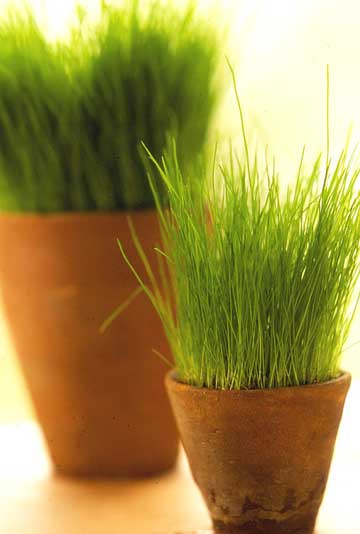






Growing grass begins with the right seeds. Although some people refer to them as wheatberries, they're actually hard red winter wheat seeds. They're readily available from health food stories or online. When buying seeds from a seed retailer or ag supply store, purchase organic seeds if you plan to consume the grass.
Wheatgrass (used as one word instead of "wheat grass") can be grown in water but is usually grown in a container filled with potting soil. You can sow seeds directly into the soil, but they get a head start when first sprouted in a jar.
continue reading belowOne cup of sprouted wheatgrass seeds covers the soil of a pot that's 7 to 8 inches in diameter. If you want to grow only the amount you need, spread the dry seeds thickly across the bottom of the container and use that amount.
Pour the wheatgrass seeds into a one-quart glass jar. Add filtered room-temperature water, cover the opening with the lid, and shake to completely rinse the seeds. Carefully drain the water, using a strainer or a lid with tiny holes. If you've removed the seeds, place them back in the jar and cover them again with fresh filtered water.
Let the seeds soak in the water for eight to 12 hours at room temperature. Rinse and drain the sprouts. If the seeds aren't showing any signs of small white roots, allow them to sit in the drained but moist jar for another eight to 12 hours, rinsing and draining every eight to 12 hours until the roots grow.
One cup of sprouted wheatgrass seeds covers the soil in a pot 7 inches in diameter or several smaller pots. Choose a container at least 2-1/2 to 3 inches deep.
Wheatgrass soil should be a lightweight potting mix (garden soil is too dense). Moisten the potting mix and place it in the pot, leaving about 1 inch of room between the soil and the top of the container.
Spread the sprouted wheatgrass seeds across the soil in a dense layer about one or two seeds deep. Gently water the soil so it is damp but not waterlogged. A spray bottle is ideal for watering.
Loosely cover the top of the pot with plastic wrap, a shower cap, or other material to keep moisture from quickly evaporating. Place the pot in a warm location, about 70 to 75 degrees F, but away from direct sunlight.
Check the wheatgrass seeds every day. By about the third to fifth day, wheatgrass should be actively growing. When the seeds have buried themselves in the potting soil and start to send up green shoots, remove the protective covering and move the pot to an indoor location in bright sunlight.
Keep the soil lightly moist with a sprayer. If you allow the soil to dry out, the tiny wheatgrass plants die.
Sprouted wheatgrass is ready to use for decorating projects or for pets in about six to eight days. Click here for decorating ideas.
You can cut wheatgrass at any stage but ideally when it reaches about 6 inches tall. The older the grass gets, the more bitter it tastes. Clip the grass just above the seed.
Just as your lawn grass does, wheatgrass continues to grow after you clip it, but the nutritional properties are lower with the second cutting. It's best to simply compost or dispose of the seeds and potting mix and start another batch.
Wheatgrass contains iron, calcium, magnesium, amino acids, chlorophyll, and vitamins A, C, and E.
However, wheatgrass may cause nausea, hives, or other discomfort. People with wheat intolerance may want to avoid it. Although wheatgrass has been touted as a treatment for various ailments, there has been little research to back up those claims.
See how to grow wheatgrass as a fun treat for your pets.
Copyright © www.100flowers.win Botanic Garden All Rights Reserved